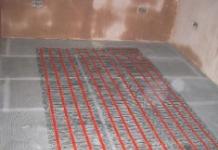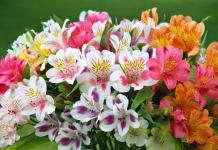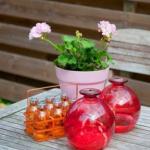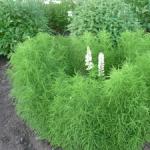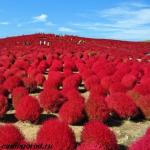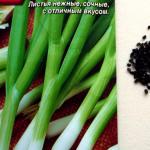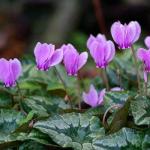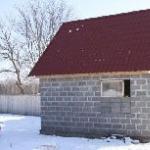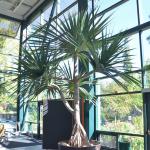To help a park or garden look original and beautiful, it is often necessary to use more than just traditional plants. A good effect is provided by annual cypresses. Among flower growers, they are also known as kochia, which has many advantages. Many appreciate it for its unpretentiousness and the absence of strict requirements for the landing site. Such an operation that is detrimental to many plants, such as pruning and shaping a bush, does not affect the further development of kochia, since this plant is gaining leaf mass in a fairly short time.
Usually planting cypress is carried out in late spring. In this case, when creating favorable conditions, this annual can grow up to 1 m in height. From the point of view of landscape design, kochia is attractive in that it retains a beautiful columnar shape. Many people like her with a neat crown, which is why she is perceived by many gardeners as a miniature cypress.
Cochia varieties
Sometimes this plant, which is widely used in landscape design, is called broom cochia, for which there is a completely logical explanation. The fact is that once this plant was cultivated to obtain brooms for household needs. However, as interest in kochia has increased, a large number of new varieties have appeared, distinguished by a variety of foliage color palettes. Therefore, today, for the design of the site, you can use cypresses of salad, emerald green, pinkish and almost purple hues, choosing from them the one that best matches the general style of the territory.
Kokhiya is one of the brightest representatives of the Marev family. In fact, she is a semi-shrub, as indicated by its stems, which are succulent and supple at every stretch. Cochia is represented in the wild in the south of Europe, in Australia, in North and South America. Because of this, it is difficult to say where this plant first appeared. In the process of development, it forms a large number of branches, which are decorated with narrow leaves attached to separate branches.
There are quite unique varieties of kochia that begin to transform in autumn: at this time of the year, instead of their usual color, the leaves turn purple. From this, kochia retains a very bright and decorative appearance until the first frost. Some varieties of plants, even with a cold snap, do not lose their juicy greenery, which also makes them very elegant. If you pay attention to the flowers, they do not stand out for their pronounced decorative properties, since they are located in the axils of the foliage and are hidden from view.
Kochia: planting and care
 Observations show that this plant feels better in steppe and semi-desert conditions. Therefore, if you want to grow summer cyprus kochia in your garden, then it is advisable to place it in sunny areas. And it's good if they are open. If the kochia remains without moisture for some time, then this will not harm her much. The consequences may turn out to be completely different if it grows in conditions of stagnant water or good drainage is not provided for it before planting.
Observations show that this plant feels better in steppe and semi-desert conditions. Therefore, if you want to grow summer cyprus kochia in your garden, then it is advisable to place it in sunny areas. And it's good if they are open. If the kochia remains without moisture for some time, then this will not harm her much. The consequences may turn out to be completely different if it grows in conditions of stagnant water or good drainage is not provided for it before planting.
The owner does not have to worry about carrying out top dressing to provide the bushes with the necessary nutrients. On almost any soil, kochia feels good, the only exceptions are acidic. Therefore, this moment must be taken into account when choosing a place for sowing seeds and transplanting adult seedlings. However, if you want the bushes to be able to acquire their maximum size during the growing process, then it is recommended to apply fertilizer to the soil during planting.
Landing features
Plants should be placed at a distance of at least 30 cm, and even better if it is increased to 50. In this case, during the first stage of growth, the cochia will spend all its energy on gaining vegetative mass and only after that will it enter the flowering phase. At this point, it stops growing. Due to the lack of free space for growth, the process of bud formation begins, which makes it difficult for the flowers to acquire a beautiful, natural shape.
Kochia summer cyprus applies among cold-resistant crops, therefore, it is necessary to plan its landing no earlier than the first decade of May. However, if you are itching to quickly enjoy its flowering, then you can start growing seedlings.
But you can choose another way - sowing seeds in open ground. However, in this case, you will have to protect the planting from frost.
Kohiya: growing from seed
The easiest way to get beautiful and large kochia bushes is grow it in a greenhouse. In this case, you will have the opportunity to place the bushes when planting in the way you yourself want. Usually, when sown, all seeds germinate, and young bushes show excellent survival rate when transplanted.

 If you decide to immediately sow the seeds in open ground, then you will have to carry out frequent watering especially during the first months of growth. This is very important, because it is at this time that the formation of the vegetative mass occurs. At other stages of development, plants are undemanding to care. They respond well to weeding, as this allows you to increase the amount of incoming air.
If you decide to immediately sow the seeds in open ground, then you will have to carry out frequent watering especially during the first months of growth. This is very important, because it is at this time that the formation of the vegetative mass occurs. At other stages of development, plants are undemanding to care. They respond well to weeding, as this allows you to increase the amount of incoming air.
The second top dressing is usually planned a month after germination. At this time it is recommended apply mineral fertilizers. If you create favorable conditions for growth, then the bush takes about a month and a half to reach its maximum height, and from that moment the process of crown formation begins. Kohiya summer cyprus tolerates a haircut without consequences, so it can be regularly given the necessary shape.
At the end of the next pruning under the bush, it is recommended to apply nitrogen fertilizers. It is also useful to feed plants with liquid nutrient solutions. Although she can do without them, however, such fertilizers also have a good effect on her condition. If you constantly make top dressing for kochia summer cyprus, then she can easily tolerate a haircut every two weeks.
Many gardeners like Kochia because resistant to many diseases. Although it cannot cope with some pests, for example, spider mites. When signs of infection are found, it is often necessary to use special preparations. Since this plant consists of dense foliage, for her spraying is useful, which is recommended to be carried out twice a season with an interval of two weeks.
It is usually enough to look at the plant to understand what it needs most.
- if the plant lacks moisture, then its foliage will wilt, and this will certainly affect the attractiveness of the plant. To correct this situation, you need to water as soon as possible - this usually allows you to return the decorative properties to the bushes again.
- if the problem is related to nutritional deficiencies, then the kochia begins to fade, its color loses its former beauty. The solution in this situation may be the introduction of liquid fertilizers.
Preparing for winter
 Since kochia is an annual plant, it is dug up in autumn, thereby preparing a place for planting next year. For sheltering perennial varieties, you can use any materials available, combining them with crown shortening. A favorable moment for opening in the spring is the period when the frosts have passed. For central Russia, this moment usually occurs in mid-May.
Since kochia is an annual plant, it is dug up in autumn, thereby preparing a place for planting next year. For sheltering perennial varieties, you can use any materials available, combining them with crown shortening. A favorable moment for opening in the spring is the period when the frosts have passed. For central Russia, this moment usually occurs in mid-May.
Kochia impresses many with its pronounced decorative properties, so it can often be found in gardens and parks. Moreover, it remains in demand also because it is easy to grow it in various conditions. However, it will still be necessary to specific activities:
- first of all, it is necessary to monitor the absence of weeds near it;
- it is also necessary to prevent the appearance of flowers and other cultivated plants between the bushes;
- if there is enough free space near the root zone, then this will create an excellent opportunity for the formation of a crown that can acquire a perfectly symmetrical shape.
Conclusion
 Many owners of suburban areas often want to see in their garden not only plants familiar to our country, but also quite original specimens. Therefore, often the choice of many of them falls on kokhiya. This annual culture fully justifies their decision, since does not create problems with growing and care. A clear confirmation is that kohiya today can be found not only in gardens, but also in parks.
Many owners of suburban areas often want to see in their garden not only plants familiar to our country, but also quite original specimens. Therefore, often the choice of many of them falls on kokhiya. This annual culture fully justifies their decision, since does not create problems with growing and care. A clear confirmation is that kohiya today can be found not only in gardens, but also in parks.
In general, the high interest in the plant, which is regularly used in landscape design, is due to its unpretentiousness in care. After all, the main difficulties arise only with the cultivation of young seedlings. Mature plants can often do without moisture without losing their attractiveness. The only thing you need to take care of is protection from freezing, as this can greatly harm the plant.
cochia plant














Kochia is an annual or perennial subshrub of the Amaranth family. In another way it is called summer cypress. The plant is mainly distributed in the desert and steppe zones of North America, Africa and Eurasia. Kohiya is often used in landscape design, as it can quickly gain "green mass" and easily tolerates shaping haircut. Its feature is the ability to change color with the onset of autumn.
- Sultan is a low variety, reaching a height of 60 cm. Rounded bushes that turn red in autumn.
- Jade is a fast-growing plant 100 cm high. It is used for curly haircuts.
- Green Forest - grows up to one meter. Easily tolerates pruning and is suitable for group compositions. It is often used to decorate paths in the garden.
- small-fraction high-moor peat;
- perlite;
- crushed humus;
- fine-grained river sand.
- potassium chloride;
- superphosphate;
- ammonium nitrate.
Show all
Description
Kohiya is an ornamental plant with a lush, developed crown. The shrub reaches a height of 60–150 cm. It consists of an upright lignified stem and many branched thin shoots. The leaves are thin, linear, entire, petiolate, soft to the touch, resembling cypress needles in appearance. Covered with short fur.
The leaf plates of a young bush are light green or dark green in color. Closer to autumn, they acquire an orange, yellow, pink or crimson hue. The tap root goes into the ground by 3 meters.
The flowers are inconspicuous, very small, spicate or paniculate, collected in inflorescences and located in the axils of the apical leaves. Summer cypress blooms from July to September. The fruits are miniature nuts with seeds that remain viable for two years. If they are not collected, they scatter on the ground and sprout in the spring even in Siberia, growing up to one meter by August.
Fresh leaves of the plant are added to soups. Cochia is also used in medicine: it helps with gonorrhea, edema, rheumatism, skin inflammation, erysipelas, eczema. The plant has tonic, bactericidal, cardiotonic, diaphoretic, laxative and diuretic properties.
Species and varieties
The most popular types and varieties of cochia used in landscape design:
| View | Description | Varieties |
Cochia broom  | This is a low spherical plant. With the advent of autumn, the bush becomes reddish-burgundy. It endures a slight frost and retains its decorative appearance until late autumn. | |
Kochia woollyflower  | The stem of the plant is covered with curly short hairs. Grows in height up to 60-80 cm | |
Kochia densely flowered  | Tall species, up to 130 cm high, with horizontally arranged shoots. The flowers at the base have long white hairs that give the shoots a slight pubescence. |

Growing seedlings
Cochia is grown through seedlings, and seeds are sown directly in open ground. Seedling plants come into vegetation much earlier, take shape faster and acquire a decorative look. Planted directly into the ground grow more slowly, but they are more resistant to disease and adverse weather conditions.
Since summer cypress is used for decorative purposes, it is more convenient to grow it with seedlings at home. Sowing dates depend on climatic conditions. In the middle lane, kochia is planted for seedlings in the last week of March. For this, containers with a depth of 12 cm are used. The soil for planting should consist of the following components:
The soil is disinfected. To do this, it is heated in the oven at a temperature of +60 degrees, after which it is spilled with a solution of potassium permanganate. Prepared soil fill boxes. The surface of the soil is leveled, lightly compacted and well moistened. Seeds are evenly distributed over the surface, without deepening into the substrate. From above they are sprinkled with a thin layer of sand, which is then moistened.
The boxes are covered with spunbond or lutrasil and taken to a bright room with a temperature of +18 ... +20 degrees. Sprouts germinate in 8-10 days. The shelter is removed, and the container is moved to another place where the temperature is 3-5 degrees lower. Water the seedlings with a thin stream of water.
Seedlings often become infected with blackleg. To protect it from death, you need to maintain the optimum temperature.
It is impossible to allow overflow and soaking of the soil, but it should not dry out either. At the slightest hint of drought, the leaves wither and recover with great difficulty. If drainage is laid in the seedling containers, and the soil is light and loose, then the sprouts should be watered twice a week.

Picking, top dressing and disembarkation
So that the kochia bush does not grow too fluffy, retain its compactness and neat appearance, the seedlings should dive into separate pots with a diameter of 10 cm. They are transplanted 2-3 weeks after the sprouts appear, while they should have at least 2 leaves. Tanks and soil are disinfected. Three seedlings are placed in each pot. Subsequently, the weak ones are removed, and the strong ones are left for landing. Containers are placed in the brightest place.
Sprouts before planting in open ground must be fed three times. For the first time, complex fertilizer is used for seedlings a few days after diving. The next top dressing is carried out after 2 weeks, using also a complex agent in which nitrogen predominates.
You can plant seedlings in open ground in mid-May, but it is advisable to wait until the end of the month. The place is chosen sunny, without drafts. The soil should be loose, fertile and not waterlogged. If the sprouts are planted in an ordinary flower garden, then the distance between them should be 30 cm, and if the plant is used as a low hedge or border, then 15 cm. While the bushes take root, they are watered abundantly, and after 2 weeks they are fed. Then carry out the first haircut and fertilize again.
Planting seeds in open ground
Kohiya can be grown from seeds that are planted directly in open ground. This is usually done in May, when the daytime temperature is +18 degrees, and at night it should not fall below +12 degrees. The soil in a sunny place is loosened, crushed lumps and watered. It is best to sow the seeds in the morning, distributing them over the surface of the soil. You don’t need to sprinkle them, but you should press them a little into the top layer of the earth and cover them with a non-woven fabric.
Growing kochia in this case will last much longer, since seedlings appear only after three weeks and often look stunted. The fabric is removed, and young plants are thinned out so that the distance between them is at least 10 cm.
Sowing in open ground is carried out in late autumn. This should be done shortly before the onset of frost, but not before, otherwise the seeds may germinate and die in winter.
Care
Kohiya does not have special care requirements if the soil is well saturated with nutrients and permeable to water. It is a drought-resistant plant, so with regular rainfall, it does not need to be watered additionally. But if the weather is hot and dry, then summer cypress must be systematically moistened for good growth. At the same time, stagnation of water in the soil should not be allowed, because of this its decorative properties deteriorate, and sometimes the plant even dies.
Every 10 days, kochia is fed with mineral fertilizer, in which there should be more nitrogen than potassium and phosphorus. For top dressing, you can use:
The plant must be weeded. It has fairly stable stems, there is no need to tie them up. With the right conditions, the bush can reach its peak height in a month or a little more.
Summer cypress grows quickly enough, as it gives a lot of shoots. It tolerates pruning and shaping well. Bushes after each haircut need to be fed with ammonium nitrate. The procedure is carried out 1-2 times a month, giving them a certain shape. It can be a pyramid, an egg, a column, a cube, a ball. The top needs to be pinched in time.
Diseases and pests
Kokhiya is resistant to diseases and pests. If rot develops in a rainy summer, then diseased bushes are destroyed, and healthy ones are watered with potassium permanganate.
Sometimes a spider mite attacks a plant, which damages its greenery. To get rid of it, special preparations are used - Akarin, Neoron, Bitoxibacillin. You can also use a decoction of cyclamen tubers or a soap solution.
Not only brightly flowering crops can help create a pleasant atmosphere in the backyard. An original and quite successful solution is planting kochia. The absence of flowers on the plant more than pays off with the unusual shape and color of delicate spherical bushes, which, if desired, can be given the most intricate outlines.

On this page of the site about the economy, we will consider the only way to breed kokhiya - growing from seed(when to plant and how to care). The plant is interesting not only for its high decorativeness, but also for its extremely low demands. Even a beginner can handle growing kochia without much effort.
 Many varieties of cochia change color in autumn.
Many varieties of cochia change color in autumn. Brief information. Kochia is from China. The culture forms lush bushes about 1 m in height and has about 80 varieties. "Summer cypress" she was nicknamed because of the features of the outline. In summer, balls or ovals of kochia are green, and closer to autumn, many varieties turn yellow, orange or burgundy. This is an annual crop that reproduces by self-sowing.
 Cochia seeds can be planted in open ground and in a container for growing seedlings
Cochia seeds can be planted in open ground and in a container for growing seedlings When to plant kochia seeds?
Cochia seeds are small, but if planted properly, they sprout beautifully. Gardeners practice two ways of growing crops:
Straight. Immediately on the site, cochia seeds are sown mainly in the southern regions. Do it at the end of spring - usually in May when the main colds pass. The culture tolerates small frosts calmly, but temperature fluctuations can slow down its development. Small kochia seeds germinate only in the presence of light, so they should not be covered with soil after sowing. You can only press them a little with a board or palm.
Through seedlings. Most land owners want elegant kochia bushes to decorate their property as soon as possible. Growing seedlings helps to achieve this goal. Planting seeds in this case is carried out in early spring ( March, April). In May, already well-developed bushes are transplanted into open ground.
 Cochia seedlings are unpretentious in care
Cochia seedlings are unpretentious in care Growing seedlings of "summer cypress"
Kochia has good germination and, if you follow the characteristics of sowing and growing, you can get strong seedlings. After planting, powerful seedlings develop rapidly, becoming a full-fledged decoration of the backyard.
Landing Features:
The landing period is March or April.
For growing cochia seedlings, universal flower soil or garden soil with humus is suitable.
The soil should be moistened before sowing.
After sowing, the seeds do not need to be covered with earth, since without light they will not germinate. It is enough to press them a little with your hand.
The container is placed in a warm place - 18-23 ° C - with access to scattered sunlight.  Seeds do not need to be sprinkled with earth
Seeds do not need to be sprinkled with earth
The nuances of caring for seedlings:
As soon as sprouts appear - on the 7-9th day - the kochia should be placed in a sunny place. Lack of light will cause the plant to become tall and thin. If this nevertheless happened, it is worth cutting off the top so that the bush subsequently acquires a more rounded shape. Such a plant must be moved to a more lit place.
Seedlings about 7 cm tall should be transplanted. Picking into wider pots must be carried out carefully, digging out the bushes along with an earthy clod.
In May, seedlings of cochia are planted in the garden. At this point, it should reach a height of 15-20 cm.
 Picking must be done very carefully.
Picking must be done very carefully. Planting seedlings in the garden:
Before placing the seedlings, the holes should be watered abundantly.
Young kochia seedlings are placed in the hole along with a clod of earth. Ideal in this respect would be transplanting seedlings that were grown in peat cups.
 Originally trimmed kochia bushes
Originally trimmed kochia bushes Kohiya in the garden - growing features
For growing kochia, choose a sunny site without drafts and cold winds. Be sure to take care of the composition of the soil. Make it close to the one in the plant's natural habitat. This means that it should be light and conduct water well.
Where does kochia look best? From a decorative point of view, it is better to plant a culture as a fence or borders. It looks great on different types of flower beds, combining without problems with many types of flowering and non-flowering ornamental crops. Kohiya can become an accent of a rock garden or a beautiful frame for a classic flower bed. If there is a large free area, you can arrange a composition consisting exclusively of kochia bushes. In this case, it is better to use different plant varieties.
 Making a flower bed with kochia
Making a flower bed with kochia Adult kochia also needs regular watering. There is no need for frequent fertilization of the crop. It is enough to use complex fertilizers only twice a season so that the plants are strong and do not get sick. Regular weeding will help improve air access to the roots, which is very beneficial for plants.
Kohiya gained incredible popularity due to the ability to carry out regular cutting of bushes. You can give them the most interesting shapes or constantly maintain a certain height. The culture perfectly tolerates frequent haircuts - every two weeks. After the procedure, a small amount of fertilizer can be applied to the soil to increase the resistance of plants.
 Kochia tolerates frequent haircuts
Kochia tolerates frequent haircuts Important! If you notice that a kochia bush has grafted, most likely it does not have enough watering. In case of loss of color and decorative qualities by the plant, it is necessary to carry out top dressing. Or the lack of light may be the culprit.
Kohiya is a beautiful ornamental plant with "fluffy" branches. It is often called summer cypress because of the many narrow leaves and the original shape of the bushes. This is a frequent element of landscape design of suburban areas and parks. The shrub grows quickly, unpretentious to the conditions of care. It lends itself well to pruning, which makes it possible to use kochia as a hedge element. Further in the article you will find about growing kochia from seeds and how to care for it.
Description of the Kochia plant
Kochia is an annual densely branched plant from the Marev family. Thanks to the geometrically correct, pyramidal shape of the bushes and narrow leaves, it received the common name "summer cypress". Another common name is broom grass, because kochia makes beautiful brooms.
Appearance of the shrub
The species of cochia is named after the German botanist Wilhelm Joseph Koch, although China is the birthplace of this plant. It grows wild in the desert areas of Eastern and Central Europe, Asia, and North America. Fast growing shrubs sometimes reach a height of 1.5 meters.
It is a shrub of moldboard or pyramidal shape with many branches. Thin branches are densely covered with leaves of light green color. In autumn, the leaves turn carmine, red or orange. The flowers are inconspicuous, small, spike-shaped. Cochia seeds are single small nuts of a dark shade, after full ripening they remain viable for up to 2 years.
After full ripening, the seeds crumble to the ground and germinate the next year. Thus, if desired, kochia can also grow "self-seeding".
Kohiya loves open space, so growing it in flowerpots is not a good idea. The bush will grow inconspicuous, and quickly changes the color of the leaves to autumn.
Types and varieties of decorative cypress
The Kochia family has more than 80 species. The most common types of kochia used in horticulture are:
- broom (divided into 2 large subspecies: hairy kochia and Childs kochia);
- creeping;
- densely flowered;
- woolly flowered.
The most popular varieties of cochia:
- Acapulco Silver. Bushy shrub up to 1 meter high. The leaves are two-tone, at the ends have a beautiful silver tint. Quite rare, but very decorative variety;

Acapulco Silver
- cochia cypress. Pyramidal bushes up to 1.5 meters high, with very thin leaves. Good for haircut. Looks good as a hedge element;
- Shilzy. Bushes are rounded, up to 1 meter high. In this case, the width of the bush reaches 60 centimeters. The peculiarity of the variety is that the leaves of the plant acquire a beautiful purple-red color early.
- Sultan. Compact shrub up to 1 meter high. It has a characteristic "open" shape of the bush.
- Green Leys. Bushes oval, up to 1 meter high. Beautiful emerald green leaves give the bushes additional decorative effect;
- The Royal Castle. Bushes are oval-pyramidal in shape, from 70 centimeters to 1 meter high. Small leaves of a pale green hue in autumn are painted in burgundy.

the Royal Castle
Kochia is a fast-growing annual that allows you to experiment with the appearance of a flower garden or hedge. If you don’t like it, you can remove dried bushes in the fall. The following spring, you can sow a different variety.
There are also perennial types of kochia. But as an ornamental plant, they are rarely used, most often it is a fodder crop.
Landing dates
Kochia is quite unpretentious in care, but does not tolerate cold. Landing in open ground is best done in late April - early May, when there is no longer a threat of the last frost. Seeds for seedlings are sown in late March or early April. This allows you to get good seedlings at the end of April.
Return frosts can kill plants. Therefore, if the spring is cold, landing in open ground should be postponed to the end of May or even the beginning of June.
Growing from seed
Kochia is propagated in 2 main ways:
- seeds in open ground;
- seedlings.
It is most exciting to grow cochia from seedlings. Young plants are planted in open ground, having a height of 10 - 15 centimeters.
Cochia seeds have almost 100% germination, which is why they do not require preliminary preparation.
Sowing
Seeds for growing seedlings are sown in late March - early April. For this:

- Spacious boxes are filled with nutrient substrate for succulents;
- The soil is plentifully watered and loosened;
- Seeds are poured in rows into the prepared nutrient substrate. They do not need to be sprinkled with earth, but only slightly pressed into the ground.
The boxes are covered with white spunbond and placed in a bright, warm place.
Cochia seeds germinate only in the light. They can not be buried deep, or sprinkled with a thick layer of soil.
seedling care
The earth is regularly moistened, kochia loves heat and moisture. Covering material is removed when the first shoots appear. Seedling care includes:
- moderate but frequent watering;
- regular loosening of the soil;
- every week fertilizing with mineral fertilizers in liquid form is carried out;
- regular weeding.

seedling material
After 2-3 true leaves appear on the seedlings, they are transplanted into separate pots. The picking of seedlings is carried out in pots up to 10 centimeters high.
At the stage of seed germination, the air temperature in the room should be 18 - 20 C. After the first shoots appear, it must be reduced to 10 - 15 C.
How to plant in open ground
Strengthened seedlings are planted in open ground when their height reaches 10-15 centimeters. In order for the bushes to be beautiful and healthy, any garden soil into which humus has been introduced is suitable. Kochia loves the sun's rays, without this she will grow weak, and the leaves will be pale and ugly. But she is afraid of the cold wind, the site must be protected from drafts. Acid and often flooded soils are not suitable for growing cochia.

Landing in the ground
Kochia easily tolerates drought, but does not like cold weather. If desired, you can plant it even in partial shade. For landing in open ground:
- Dig holes at a distance of 40 - 50 centimeters from each other. Do not plant this plant too closely. Otherwise, it will turn into an unattractive "broom" instead of a luxurious bush;
- Seedlings are lowered into the prepared holes and covered with soil.
After that, the seedlings are watered abundantly, the earth should not dry out from above.
Kochia is afraid of the cold wind, losing its decorative appearance.
Care
Regular care for kochia bushes includes:
- Constant watering. Cochia bushes tolerate drought well, but their decorative effect is reduced. It is necessary to ensure that the top layer of soil around the bushes does not turn into a dried crust;
- Soil loosening and weeding. This will make the soil lighter and help get rid of weeds;
- Top dressing. During the period of intensive plant growth, it is advisable to feed them with liquid nitrogen fertilizers. This should definitely be done after pruning to help the plant recover.

liquid nitrogen fertilizer
Kochia tolerates pruning well. Thanks to this bushes, you can give any shape. You can repeat the procedure every 2 to 3 weeks, as the plant recovers quickly.
It is not necessary to maintain the natural shape of the bushes inherent in this variety. With the help of figured trimming, they can easily be given the appearance of a ball, cube, egg or column.
Diseases and pests
The main pest that poses a threat to kochia is the spider mite. It is easy to notice it, characteristic whitish "cobwebs" form on the leaves and branches. If this problem occurs, you should immediately spray the plants with insecticides. For this, Neotron can be used at a concentration of 1 milliliter per 1 liter of water.
Kochia is not susceptible to infectious or infectious diseases. This is due to the stable immunity of the plant.
Video
For more details on planting and growing kochia, see the video
Conclusion
Emerald green or pale green kochia goes well with perennials such as blue spruce, thuja and fir. As an element of landscape design, it perfectly sets off the bright colors of flower beds. Neat spherical bushes in autumn change the color of the leaves to carmine red or crimson. It is unpretentious in care, grows quickly and is practically not susceptible to disease.
Kohii grow in America, Europe, Asia and Australia. They are all herbaceous plants with upright, highly branched stems and entire, narrow leaves that range in shape from linear to filiform. There are annual and perennial species.
Kochia bloom, but their inflorescences are small and inconspicuous. Corollas are collected in panicles or spikelets. There are about 1400 seeds in one gram of seeds.
There is no consensus among taxonomists which family this flower belongs to. Sometimes he is reckoned with the Amaranths, in other cases with the Marevs. Among gardeners, kochia is known as "summer cypress".
Types of cochia
About 80 species of kochia are known, but not all of them have decorative qualities. So, on the territory of our country there is a perennial prostrate kochia (Kochia prostrata). It is used for agricultural purposes as a fodder plant, but is unsuitable for flower beds.

Kochia prostrata
In ornamental gardening, broom kochia (bássia scopária) is usually cultivated. This is an annual beautiful plant up to 1 m high. The leaves are lanceolate, pubescent, bright green, small.
Cochia broom reaches its full size in July, forming bushes resembling cypresses directed upwards in shape. By autumn, its green leaves turn bright red.
Species broom kochia is not of decorative interest. In the wild, it grows in wastelands like a common weed. In gardens and flower beds, its hair-like variety is planted with very narrow, pubescent leaves up to 5 cm long.
Several varieties of hairy have been bred:

Cochia propagation - how to grow from seeds?
The only way to grow emerald kochia bushes in the garden is to buy or harvest seeds yourself and sow them at home.
Seeds germinate no more than 1-2 years. They are sown in April in a room or greenhouse, in a common box. At temperatures above 20 degrees, seedlings will appear in 5-6 days. Then they are grown one at a time in a pot or transplanted immediately to the bed under the film.
The diameter of the pot is 7 cm. It will be necessary to carry out one transshipment into 10-11 cm containers. When picking from a box to a greenhouse, 20 cm is left between plants. Without shelter, kochia can be planted in a permanent place in the 2nd-3rd decade of May.

The plant is afraid of frost. Once under the cold, the seedlings will stop growing and turn red.
In the southern regions, the plant propagates by self-sowing. Savage bushes can be grown by sheltering from spring frosts with cut plastic bottles, and then transplanted to a permanent place.
Seeds of summer cypress quickly lose their germination. When buying them, you need to carefully look at the production date stamped on the bag.
It is better to purchase seed from well-known companies that use polyethylene or foil vacuum envelopes for packaging and treat the seeds with fungicides.
Seedlings need a lot of light and moderate heat. When overflowing, cochia quickly dies from the black leg. To save seedlings, you need to sow the seeds in loose, moisture-permeable soil and moderately water with water at room temperature.
When growing kochia from seeds, you need to decide when to plant them. Sowing should be carried out in such a way that the seedlings get to a permanent place a month after the emergence of seedlings on the surface of the soil.
Sowing technology:
- Pour a layer of substrate 5 cm high into a wide container.
- Tamp with your palm.
- Scatter the seeds over the surface.
- Sprinkle with a layer of sand 2-3 mm,
- Spray with water from a spray bottle.
- Cover with glass or film.
- Put in a place with a temperature of 20-22 degrees.
The land must be fresh, not previously used for growing seedlings. It is better to purchase a universal soil in the store with a ph of 5.5-6.5.
Immediately after the appearance of seedlings on the soil surface, the temperature must be reduced to +12 ... +15 and bright. If one or two plants in the box suffer from a black leg, it is enough to simply remove them along with a clod of earth and spill the holes with a solution of potassium permanganate of medium color intensity.
Video from Yana Fedorova:
Landing features
Kochia has a clearly defined, upward-looking bush, the diameter of which can reach, depending on the variety, 1 m. This must be taken into account when planning its planting.
The minimum distance between plants should be 30 cm. This is how cochia is planted in hedges.
In thickened plantings, the bushes have little space and light, which is why they dry out and completely lose their decorative appearance. Therefore, when planting in a flower garden, more space is left between adjacent specimens - 50-100 cm.
Plants are unpretentious, undemanding to humus and the sun, but look as beautiful as possible in sunny places and nutritious soil. Cochia does not tolerate overly acidic and wet soils - the roots begin to die off, and the foliage dries up.
Before planting seedlings in the ground, it is advisable to fertilize the soil with nitrogen fertilizer and dig it with a pitchfork. Nitrate top dressing contributes to a bright green color of the leaves.
Seedlings are planted together with a clod of earth to the same depth at which they grew in a pot.
Difficulties of growing from seeds - tips for flower growers:
plant care
Care consists of watering and cutting or pinching.
Immediately after planting on the street, seedlings should be watered abundantly. If the soil dries out, and the plants have not yet had time to take root, the leaves will fall down and the planting will become miserable.
The main requirement of kokhiya to the soil is friability. At first, the earth near the bush will have to be constantly fluffed up, deepening the rake by no more than 2-3 cm. With deep processing, the roots can be damaged, which in summer cypress are a superficially located rhizome.
Even a day in the heat, spent without water, leads to wilting of the flower. You need to water the bushes in the morning or in the evening, when there is no bright sunlight. Humidification in the sun will cause the luxurious leaves to get burned and wither.
Plants tolerate shading, but it is necessary that the shade is not dense in the morning. With a lack of light, the bushes lag behind in development, turn pale and become ugly.
During the growing season, you need to feed the summer cypress twice with a complex fertilizer dissolved in water containing nitrogen, phosphorus and potassium. The first top dressing is done a month after planting the seedlings in the ground, the second in the middle of summer.
The plant tolerates liquid fertilizers better than loose or granular ones, so even manure is recommended to be infused in water.
All top dressing is carried out only under the root. Spraying on the leaves is impractical, as ugly spots may remain on the "needles".
Despite the robust appearance of summer cypress, it has pests. The most dangerous of them is the spider mite. If the leaves began to turn yellow and dry, you need to look at their reverse side. Arachnids are visible to the naked eye as small dark dots. The leaves themselves on the back are covered with a layer of cobwebs.
Instances with a tick are sprayed with Aktellik or Neoron (1 ml per liter of water). The treatment is repeated after 30 days.

Kochia in landscape design
Plants are planted in large groups or tapeworms on lawns, they enclose flowerbeds and borders. In autumn, plants can be transplanted into a container and brought into heat, where they will retain a decorative appearance for a long time.
Kochia is easy to shear. From it you can create hedges of any shape and length. Bushes are cut once every 2 weeks. They are turned into balls, pyramids, parallelepipeds and other figures. Trimmed summer cypresses planted in a row form a beautiful tetrahedral hedge or a hemispherical border.
For shearing, varieties with a dense crown and short leaves are suitable. If seeds have formed on the plant, it becomes unsuitable for shortening. The leaves on such bushes will no longer grow, and the cut branches will remain in sight.
Haircut is carried out on a cloudy day. The best tool is lawn shears. They start with simple shapes: pyramids, cubes, hemispheres. Having filled your hand, you can proceed to more complex ones: cylinders, balls. Plants after shearing retain their shape for a long time.
Kohiya can not be cut, but simply regularly remove the young tips of the branches. The result is a compact, very dense bush. After cutting, it is desirable to add complex mineral fertilizer to the soil so that the plant regains strength.
Despite the absence of flowers and the monotony of color, summer cypress attracts a lot of attention. It can be used as an accent flower garden, surrounded by smaller flowering plants.
From well-groomed bushes, luxurious garden compositions are obtained. For this, plants are combined with annual flowers: salvia, and others.
Summer cypress is magnificent not only in summer, but also in autumn. With the first cold weather, it acquires a carmine color and pleases the eye with brightness, when most decorative flowering plants have already dried up.
There are varieties that remain bright green until frost without blushing. The most beautiful of them is Acapulco Silver with silver-gray leaf tips.
Autumn kochia leaves can be dried and used in flower arrangements.
Kochia in landscape design in the photo:








